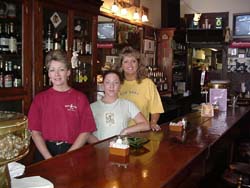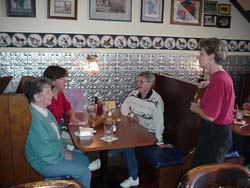|
When Susie’s father sold the Illinois Tavern in
1976, it continued to operate under new ownership until 1979.
It was then that Lou Hardacre purchased the business and,
after extensive remodeling, opened the Blue Dog Inn on October 23.
Fuhrer’s first day was Maundy Thursday in 1980.
She became a business partner in 1983 and assumed sole
proprietorship in 1990.
Why “Blue Dog Inn”?
There are several stories about the origin of the name, but
Susie shares the one about the real “Blue Dog.”
Hardacre lived on a farm that had been previously occupied
by Rick Garrett, John Verderber and two other friends.
The quartet had a pet, a female German shepherd that they
called “Dog.” When
the group moved to town, they brought Dog too, but she was so
“blue” they took her back to become a permanent part of the
farm. The Blue Dog
Inn is named after the blue “Dog.”

[From
left to right: Susie Fuhrer,
Kristina Snyder, Susie Taylor.]
When the Blue Dog first opened, lunch was served from
11 a.m. to 2 p.m., but a majority of the business was still from
the bar. There were regular customers and “everyone knew your
name.” Gradually
the business evolved, and snacks were offered in the evening.
The lunch business built when the selection was increased
and made available later than 2 p.m. The larger, all-day menu with
appetizers, burgers and fries started after a grill and fryers
were put in during a kitchen remodeling in late 1985.

Today, the Blue Dog Inn is known for its food, not as
a bar. Very little alcohol is consumed at lunch, and in the evening
the drinks are usually served with dinner.
The counter is used most often for individuals stopping by
for a sandwich. The
Blue Dog has adapted to the times, offering salads, soups,
desserts, a daily special and fish every Friday.
The number of employees has tripled over the last 10 years
and Fuhrer notes that she has “one of the best staffs” she has
ever had right now. Susie
says that she and her dozen employees are a close-knit group –
more like a family than an owner/employee relationship.
Fuhrer’s favorite aspects of the business are the
customers and employees, and being busy.
When Susie takes a moment to fix something for herself,
it’s usually a grilled chicken or spinach salad at lunch; or a
dinner salad, blue cheese burger or chicken strips and French
fries with cheese sauce for supper.

Family ties brought Susie to the Blue Dog Inn and
still play an important role in the business.
Her father was the chief “fish fryer” when “all you
can eat catfish” was featured once a month in the late ’80s
and early ’90s, and he continues to work at least one day a
week. When Susie
decided the Blue Dog needed an update last fall, her father and
her husband, Steve, did the carpentry work while she and her
mother papered and painted.
|

The
remodeling was brought on by leakage after the building to the
north of the Blue Dog was demolished.
A more permanent solution was needed, so Bob and Steve
built an air space between the outside and inside wall.
They planned to cover the lower half with tin and paint it
brown like the Illinois Tavern had been in the ’30s, but the tin
was so attractive they decided to leave it its natural color.
New lights and wiring were installed so all the lights
could be turned out with one switch instead of individually.
All the rooms received a fresh coat of paint and were
papered, and new vanities were installed in the bathrooms.
This major renovation was accomplished in just six days
total, and the Blue Dog Inn was closed only two weekends, opening
for business in between.

Future
plans include the possibility of opening the space to the south of
the Blue Dog (formerly The Other Side of the Fence and Elder’s
Custom Cycle) for small groups and meetings.
Susie has had many requests for this type of service.
The menu would be different, pre-planned and the space
available by reservation only.
She’s also considering opening the apartment above the
restaurant.
Susie
is quick to share credit for the success of the Blue Dog Inn with
her family, especially her husband, Steve Fuhrer, whom she married
Aug. 2, 1991. He’s
quick to help with maintenance and repairs while working a
full-time job and serving as an alderman.
Most importantly to Susie, he serves as a sounding board
for her and is understanding about the hours she spends at the
Blue Dog Inn. They’ve
recently added a new member to their family, a 9-week-old puppy
dumped on their doorstep about a year ago.
“Blue” joined three cats but is the most spoiled member
of the brood. Susie
and Steve had not had a dog previously because they didn’t feel
they were home enough to take care of one, but she admits that
Blue has definitely changed their feelings.
They’re in the process now of taking his picture so he
can become the new “poster dog.”

[Susie Fuhrer chats with (left to right): Evelen
Jenkins, Marsha Dallas, and Grethen Plotner.]
In
the little free time she has, Susie serves on the Main Street
Lincoln Board of Directors and on the Design Committee and
Economic Restructuring Committee.
The Blue Dog Inn is a contributing sponsor to the upcoming
Historic Preservation Week observance.

The
Blue Dog Inn has its own website, www.bluedoginn.com,
and Susie can be e-mailed at bluedog@abelink.com.
Restaurant hours are Mondays 11 a.m. to 2 p.m., Tuesday
through Thursday 11 a.m. to 10 p.m., and Friday and Saturday 11
a.m. to 11 p.m.
[Wendy
Bell]
|
|
The
project, to cost $248,902, will be performed by RJS Construction
of Peoria and should be complete by late fall of this year.
Interior work will include plastering, painting and
remodeling of the courthouse’s two fireplaces into historically
accurate designs. A
new security system and a new storage shed will also be added.

“We
have a commitment to maintain this site for future use,”
Schachtsiek said. He believes the Looking for Lincoln project
gives the Postville Courthouse “very much potential” as a
tourist site, especially because of the research that has been
done on the Lincoln legal papers.

[The original Postville
Courthouse]
“Postville
could be as important a site as Mount Pulaski on the Looking for
Lincoln Trail because it tells what Lincoln did to make a living.
About one-half of his time he spent traveling the Eighth
Judicial Circuit. There
are only three places where you can learn about his career
traveling the Circuit – Postville, Mount Pulaski and Metamora
courthouses,” he said.
“In
the past, attention has been focused on Lincoln’s political
career, but in recent years, partly because of the Lincoln legal
papers, attention has been focusing on his legal career. We’re fortunate we’ve got two of the four Lincoln legal
sites here in Logan County: Postville and Mount Pulaski,” he
added.
The
other two legal sites are the Metamora Courthouse and the
Lincoln-Herndon law office in Springfield.
The
research has been completed on the Lincoln legal papers,
Schachtsiek said, and they are now available on CD ROM for
computers. Certain
select cases will also be published in book form.
“What the Lincoln Legal Paper project did was draw in all
the raw data. Now it
is up to other historians and researchers to interpret this data.
What this means is that Lincoln’s legal career is now
more visible and the public will, we hope, be more interested and
more curious about it, and come to sites related to that legal
career.”
|

The
town of Postville was the county seat of Logan County for eight
years, until Mount Pulaski won the honor from Postville in an 1848
referendum. In 1855
the county seat was moved again, this time to the growing town of
Lincoln, and by the time of the Civil War Lincoln had absorbed the
old town of Postville into its boundaries.
The
courthouse served as a store, a post office, a private home, and
was finally purchased by Henry Ford in 1929 for $8,000.
Ford dismantled the building and moved it to his Greenfield
Village in Dearborn, Mich., but donated the block the courthouse
had been located on to the Logan County Historical Society.

[The reconstructed Postville Courthouse was built
at the
site of the original courthouse in 1953.]
During
its centennial in 1953, the city of Lincoln presented the block of
land to the state of Illinois, which constructed a replica of the
building, based on the original in Greenfield Village.
In 1956 the “new” Postville Courthouse opened.
The first floor contains an interpretive exhibit on the
Eighth Judicial Circuit, on which Abraham Lincoln served as a
lawyer, and the second floor houses a courtroom and office furnished
as they might have been in the1840s when Lincoln was practicing
law. The Mount
Pulaski and Metamora courthouses are still the original buildings.
[Joan
Crabb]
|

